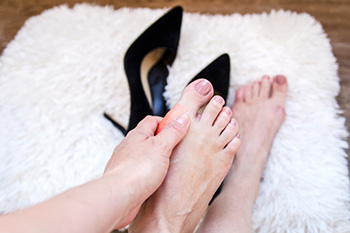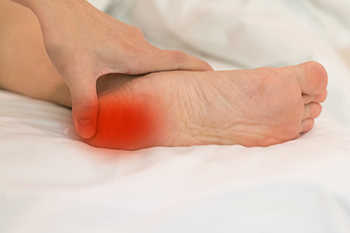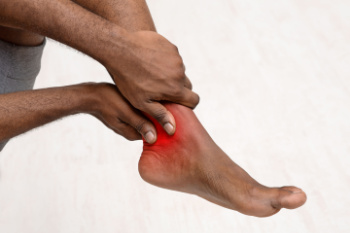Connect With Us
Blog
Items filtered by date: June 2024
Do Your Child's Feet Hurt?
How High Heels May Damage Your Feet

Wearing high heels regularly can lead to various types of foot damage. The unnatural position of the foot in high heels places excessive pressure on the ball of the foot, which can result in metatarsalgia, a painful inflammation of the metatarsal region. High heels also force the toes into a cramped position, often leading to bunions, hammertoes, and other deformities. The elevated heel shifts the body's weight forward, altering posture and putting additional stress on the knees and lower back. This unnatural alignment can cause chronic pain and long-term joint issues. Additionally, the lack of proper support in high heels can contribute to plantar fasciitis, characterized by severe heel pain. The risk of ankle sprains and fractures is also higher due to the instability of walking in high heels. Over time, the cumulative effect of these issues can lead to significant and sometimes irreversible foot and musculoskeletal problems, emphasizing the importance of moderating high-heel use and opting for more supportive footwear. If you have developed foot pain and feel it may be from wearing high heels, it is suggested that you speak to a podiatrist who can offer you treatment solutions in addition to guiding you toward safer footwear.
High heels have a history of causing foot and ankle problems. If you have any concerns about your feet or ankles, contact Philip K. Schrumpf, DPM from Active Feet Clinic. Our doctor can provide the care you need to keep you pain-free and on your feet.
Effects of High Heels on the Feet
High heels are popular shoes among women because of their many styles and societal appeal. Despite this, high heels can still cause many health problems if worn too frequently.
Which Parts of My Body Will Be Affected by High Heels?
- Ankle Joints
- Achilles Tendon – May shorten and stiffen with prolonged wear
- Balls of the Feet
- Knees – Heels cause the knees to bend constantly, creating stress on them
- Back – They decrease the spine’s ability to absorb shock, which may lead to back pain. The vertebrae of the lower back may compress.
What Kinds of Foot Problems Can Develop from Wearing High Heels?
- Corns
- Calluses
- Hammertoe
- Bunions
- Morton’s Neuroma
- Plantar Fasciitis
How Can I Still Wear High Heels and Maintain Foot Health?
If you want to wear high heeled shoes, make sure that you are not wearing them every day, as this will help prevent long term physical problems. Try wearing thicker heels as opposed to stilettos to distribute weight more evenly across the feet. Always make sure you are wearing the proper shoes for the right occasion, such as sneakers for exercising. If you walk to work, try carrying your heels with you and changing into them once you arrive at work. Adding inserts to your heels can help cushion your feet and absorb shock. Full foot inserts or metatarsal pads are available.
If you have any questions please feel free to contact our office located in Missoula, MT . We offer the newest diagnostic and treatment technologies for all your foot and ankle needs.
Anatomy and Causes of Sever's Disease

Sever's disease, a common cause of heel pain in growing children, involves inflammation of the growth plate in the heel. This condition occurs during periods of rapid growth, typically affecting active children aged eight to 14. The growth plate, or epiphyseal plate, is an area of developing cartilage tissue at the end of long bones. In Sever's disease, repetitive stress from activities like running and jumping causes inflammation and pain in the heel. Factors such as tight calf muscles, flat feet, or high arches can worsen the condition by increasing tension on the growth plate. Understanding the anatomy of the growing heel and the mechanical stresses involved is vital for identifying and managing Sever's disease. Rest, stretching exercises, and wearing supportive footwear are effective measures to alleviate symptoms and promote healing. If your active child has heel pain, it is suggested that you contact a podiatrist who can accurately diagnose and treat Sever’s disease.
Sever's disease often occurs in children and teens. If your child is experiencing foot or ankle pain, see Philip K. Schrumpf, DPM from Active Feet Clinic. Our doctor can treat your child’s foot and ankle needs.
Sever’s Disease
Sever’s disease is also known as calcaneal apophysitis, which is a medical condition that causes heel pain I none or both feet. The disease is known to affect children between the ages of 8 and 14.
Sever’s disease occurs when part of the child’s heel known as the growth plate (calcaneal epiphysis) is attached to the Achilles tendon. This area can suffer injury when the muscles and tendons of the growing foot do not keep pace with bone growth. Therefore, the constant pain which one experiences at the back of the heel will make the child unable to put any weight on the heel. The child is then forced to walk on their toes.
Symptoms
Acute pain – Pain associated with Sever’s disease is usually felt in the heel when the child engages in physical activity such as walking, jumping and or running.
Highly active – Children who are very active are among the most susceptible in experiencing Sever’s disease, because of the stress and tension placed on their feet.
If you have any questions, please feel free to contact our office located in Missoula, MT . We offer the newest diagnostic and treatment technologies for all your foot and ankle injuries.
A Surgical Procedure for Plantar Fasciitis

Endoscopic plantar fasciotomy, or EPF, is a surgical procedure used to treat plantar fasciitis. This painful foot condition is caused by inflammation of the thick band of tissue that runs along the bottom of the foot, known as the plantar fascia. During an EPF procedure, a small incision is made in the foot, and a thin, tube-like instrument called an endoscope is inserted to visualize the plantar fascia. Using specialized instruments, the podiatrist then cuts or releases the tight or damaged portion of the plantar fascia, relieving tension and reducing pain. Unlike traditional open surgery, EPF is minimally invasive and typically results in less postoperative pain, faster recovery times, and smaller scars. This procedure is often recommended for patients who have not responded to conservative treatments, such as rest, orthotic devices, or steroid injections. If you have plantar fasciitis, it is suggested that you are under the care of a podiatrist who can determine if this type of surgery is right for you.
Foot surgery is sometimes necessary to treat a foot ailment. To learn more, contact Philip K. Schrumpf, DPM of Active Feet Clinic. Our doctor will assist you with all of your foot and ankle needs.
When Is Surgery Necessary?
Foot and ankle surgery is generally reserved for cases in which less invasive, conservative procedures have failed to alleviate the problem. Some of the cases in which surgery may be necessary include:
- Removing foot deformities like bunions and bone spurs
- Severe arthritis that has caused bone issues
- Cosmetic reconstruction
What Types of Surgery Are There?
The type of surgery you receive will depend on the nature of the problem you have. Some of the possible surgeries include:
- Bunionectomy for painful bunions
- Surgical fusion for realignment of bones
- Neuropathy decompression surgery to treat nerve damage
Benefits of Surgery
Although surgery is usually a last resort, it can provide more complete pain relief compared to non-surgical methods and may allow you to finally resume full activity.
Surgical techniques have also become increasingly sophisticated. Techniques like endoscopic surgery allow for smaller incisions and faster recovery times.
If you have any questions please feel free to contact our office located in Missoula, MT . We offer the newest diagnostic and treatment technologies for all your foot and ankle needs.
Ankle Pain Caused by Arthritis
 Ankle pain from arthritis can impact your daily life substantially. Ankle arthritis occurs when the joints in your ankles become inflamed. This can lead to pain, stiffness, and restricted movement. The three types of arthritis that can affect the ankles are osteoarthritis, rheumatoid arthritis, and gout. Osteoarthritis is caused by the gradual wearing away of cartilage in the joints, causing the bones to rub against other bones. Rheumatoid arthritis is a type of arthritis where the body's immune system attacks the joints by mistake and causes inflammation. Gout is a type of arthritis that causes pain, redness, and tenderness in your joints for a week or two, then returns to normal. No matter what the type is, ankle arthritis can make daily activities like walking or standing painful and challenging. If you are experiencing ankle pain, especially in the joints, it is suggested that you consult a podiatrist, or foot doctor, to find the best treatment options.
Ankle pain from arthritis can impact your daily life substantially. Ankle arthritis occurs when the joints in your ankles become inflamed. This can lead to pain, stiffness, and restricted movement. The three types of arthritis that can affect the ankles are osteoarthritis, rheumatoid arthritis, and gout. Osteoarthritis is caused by the gradual wearing away of cartilage in the joints, causing the bones to rub against other bones. Rheumatoid arthritis is a type of arthritis where the body's immune system attacks the joints by mistake and causes inflammation. Gout is a type of arthritis that causes pain, redness, and tenderness in your joints for a week or two, then returns to normal. No matter what the type is, ankle arthritis can make daily activities like walking or standing painful and challenging. If you are experiencing ankle pain, especially in the joints, it is suggested that you consult a podiatrist, or foot doctor, to find the best treatment options.
Ankle pain can be caused by a number of problems and may be potentially serious. If you have ankle pain, consult with Philip K. Schrumpf, DPM from Active Feet Clinic. Our doctor will assess your condition and provide you with quality foot and ankle treatment.
Ankle pain is any condition that causes pain in the ankle. Due to the fact that the ankle consists of tendons, muscles, bones, and ligaments, ankle pain can come from a number of different conditions.
Causes
The most common causes of ankle pain include:
- Types of arthritis (rheumatoid, osteoarthritis, and gout)
- Ankle sprains
- Broken ankles
- Achilles tendinitis
- Achilles tendon rupture
- Stress fractures
- Bursitis
- Tarsal tunnel syndrome
- Plantar fasciitis
Symptoms
Symptoms of ankle injury vary based upon the condition. Pain may include general pain and discomfort, swelling, aching, redness, bruising, burning or stabbing sensations, and/or loss of sensation.
Diagnosis
Due to the wide variety of potential causes of ankle pain, podiatrists will utilize a number of different methods to properly diagnose ankle pain. This can include asking for personal and family medical histories and of any recent injuries. Further diagnosis may include sensation tests, a physical examination, and potentially x-rays or other imaging tests.
Treatment
Just as the range of causes varies widely, so do treatments. Some more common treatments are rest, ice packs, keeping pressure off the foot, orthotics and braces, medication for inflammation and pain, and surgery.
If you have any questions, please feel free to contact our office located in Missoula, MT . We offer the newest diagnostic and treatment technologies for all your foot care needs.
Blog Archives
- August 2024
- July 2024
- June 2024
- May 2024
- April 2024
- March 2024
- February 2024
- January 2024
- December 2023
- November 2023
- October 2023
- September 2023
- August 2023
- July 2023
- June 2023
- May 2023
- April 2023
- March 2023
- February 2023
- January 2023
- December 2022
- November 2022
- October 2022
- September 2022
- August 2022
- July 2022
- June 2022
- May 2022
- April 2022
- March 2022
- February 2022
- January 2022
- December 2021
- November 2021
- October 2021
- September 2021
- August 2021
- July 2021
- June 2021
- May 2021
- April 2021
- March 2021
- February 2021
- January 2021
- December 2020
- November 2020
- October 2020
- September 2020
- August 2020
- July 2020
- June 2020
- May 2020
- April 2020
- March 2020
- February 2020
- January 2020
- December 2019
- November 2019
- October 2019
- September 2019
- August 2019
- July 2019
- June 2019
- May 2019
- April 2019
- March 2019

